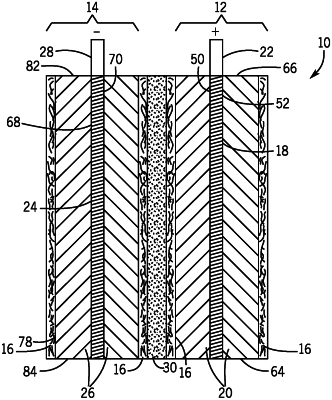| CPC H01M 4/664 (2013.01) [H01M 4/82 (2013.01); H01M 10/06 (2013.01); H01M 50/417 (2021.01); H01M 50/437 (2021.01); H01M 50/44 (2021.01); H01M 50/446 (2021.01); H01M 50/46 (2021.01); H01M 2220/20 (2013.01)] | 15 Claims |

|
1. A method of manufacturing a lead-acid pasting carrier, the method comprising:
dispersing glass microfibers in an aqueous solution to form an aqueous slurry with the glass microfibers;
dispersing a polymer component within the aqueous slurry of the glass microfibers so that the polymer component is homogenously or uniformly distributed throughout the aqueous slurry;
distributing the aqueous slurry onto a screen and removing a liquid from the aqueous slurry to form a nonwoven fiber mat comprising entangled glass microfibers;
applying a binder to the entangled glass microfibers to bond the glass microfibers together, wherein the binder may be applied to the glass microfibers by mixing in the aqueous slurry or applied to the glass microfibers after removing the liquid from the aqueous slurry; and
drying the entangled glass microfibers to form the nonwoven fiber mat having a thickness between 5 and 50 mils;
wherein a wettability of the lead acid pasting carrier enables the pasting carrier to support a conductive material by absorbing a portion of the conductive material while preventing the conductive material from passing through the lead-acid pasting carrier.
|
|
8. A method of manufacturing a lead-acid pasting carrier, the method comprising:
dispersing glass microfibers in an aqueous solution to form an aqueous slurry with the glass microfibers;
dispersing a polymer component within the aqueous slurry so that the polymer component is homogenously or uniformly distributed throughout the aqueous slurry;
distributing the aqueous slurry onto a screen and removing a liquid from the aqueous slurry to form a nonwoven fiber mat comprising entangled glass microfibers;
applying a binder to the entangled glass microfibers to bond the glass microfibers together, wherein the binder may be applied to the glass microfibers by mixing in the aqueous slurry or applied to the glass microfibers after removing the liquid from the aqueous slurry; and
drying the entangled glass microfibers to form the nonwoven fiber mat;
wherein a wettability of the lead acid pasting carrier enables the pasting carrier to support a conductive material by absorbing a portion of the conductive material while preventing the conductive material from passing through the lead-acid pasting carrier.
|